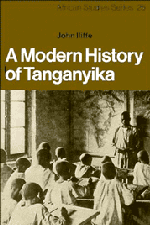Book contents
- Frontmatter
- Contents
- List of maps and tables
- Preface
- Acknowledgments
- Terminology
- Abbreviations
- Map I Tanganyika
- 1 Intentions
- 2 Tanganyika in 1800
- 3 The nineteenth century
- 4 The German conquest
- 5 Colonial economy and ecological crisis, 1890–1914
- 6 The Maji Maji rebellion, 1905–7
- 7 Religious and cultural change before 1914
- 8 Fortunes of war
- 9 The origins of rural capitalism
- 10 The creation of tribes
- 11 The crisis of colonial society, 1929–45
- 12 Townsmen and workers
- 13 The African Association, 1929–48
- 14 The new colonialism
- 15 The new politics, 1945–55
- 16 The nationalist victory, 1955–61
- Bibliography
- Index
- Frontmatter
- Contents
- List of maps and tables
- Preface
- Acknowledgments
- Terminology
- Abbreviations
- Map I Tanganyika
- 1 Intentions
- 2 Tanganyika in 1800
- 3 The nineteenth century
- 4 The German conquest
- 5 Colonial economy and ecological crisis, 1890–1914
- 6 The Maji Maji rebellion, 1905–7
- 7 Religious and cultural change before 1914
- 8 Fortunes of war
- 9 The origins of rural capitalism
- 10 The creation of tribes
- 11 The crisis of colonial society, 1929–45
- 12 Townsmen and workers
- 13 The African Association, 1929–48
- 14 The new colonialism
- 15 The new politics, 1945–55
- 16 The nationalist victory, 1955–61
- Bibliography
- Index
Summary
It was in the towns that Europeans first lost control of Africa. Depression and war had their greatest impact on Tanganyika's townsmen: on educated men who formed the African Association and on workers whose labour movement culminated in 1947 in a general strike which was both the climax of the colonial crisis and the first modern, popular, multi-tribal movement in Tanganyika's history. Both African Association and labour movement took much of their character from the social organisation of the capital, where each quarter had a particular social composition corresponding to a distinct phase in the country's history. To understand Dar es Salaam's particularity, however, it is first necessary to examine the social organisation of Tanganyika's towns in general – a difficult task where so little urban history has been written.
Urban diversity and social categories
Pre-colonial towns were located on the coast, along caravan routes, or at the capitals of powerful chiefs like Kimweri and Merere. With walls razed, rulers impoverished, and inhabitants dispersed, royal capitals disintegrated under German rule. Vugha burned down and was not rebuilt. Utengule Usafwa was deliberately destroyed by the Germans. Some commercial towns survived better, for the colonial economy was still based on the coast and on east-west lines of communication. Dar es Salaam, Tanga, and Lindi prospered as European administrative and commercial centres, but other ports decayed. Some inland trading settlements, such as Tabora, became administrative headquarters, but more were displaced by German stations on sites determined by transport, strategic and political considerations, and suitability for European habitation.
- Type
- Chapter
- Information
- A Modern History of Tanganyika , pp. 381 - 404Publisher: Cambridge University PressPrint publication year: 1979

